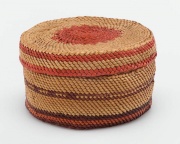Difference between revisions of "Aniline dye"
(username removed) |
(username removed) |
||
| Line 2: | Line 2: | ||
== Description == | == Description == | ||
| − | Any of a group of dyes derived from aniline which is a coal-tar distillation product. Aniline dyes were the first synthetically produced basic dyes. The method for the production of [http://cameo.mfa.org/materials/fullrecord.asp?name=mauve mauve] (mauveine) was discovered in 1856 in England by William Perkin. This quickly spawned a new area of research into triphenylmethane dyes from which the second aniline based dye, [http://cameo.mfa.org/materials/fullrecord.asp?name=magenta magenta] (fuchsin), was discovered. By 1861, many colors were being synthesized ranging from yellow to red to blue. These colors are very brilliant but many lack the permanence of inorganic pigments. In spite of this, they are still used in watercolors, inks and fabric dyes. See also [http://cameo.mfa.org/materials/fullrecord.asp?name=aniline | + | Any of a group of dyes derived from aniline which is a coal-tar distillation product. Aniline dyes were the first synthetically produced basic dyes. The method for the production of [http://cameo.mfa.org/materials/fullrecord.asp?name=mauve mauve] (mauveine) was discovered in 1856 in England by William Perkin. This quickly spawned a new area of research into triphenylmethane dyes from which the second aniline based dye, [http://cameo.mfa.org/materials/fullrecord.asp?name=magenta magenta] (fuchsin), was discovered. By 1861, many colors were being synthesized ranging from yellow to red to blue. These colors are very brilliant but many lack the permanence of inorganic pigments. In spite of this, they are still used in watercolors, inks and fabric dyes. See also [http://cameo.mfa.org/materials/fullrecord.asp?name=aniline%20green aniline green], [http://cameo.mfa.org/materials/fullrecord.asp?name=chrysotoluidine aniline yellow], [http://cameo.mfa.org/materials/fullrecord.asp?name=aniline%20brown aniline brown], and [http://cameo.mfa.org/materials/fullrecord.asp?name=aniline%20black aniline black]. |
== Synonyms and Related Terms == | == Synonyms and Related Terms == | ||
| − | aniline colors; coal tar colors; coal-tar colors; rojo de anilina (Esp.); colorants | + | aniline colors; coal tar colors; coal-tar colors; rojo de anilina (Esp.); colorants à l'aniline (Fr.); colorante all'anilina (It.); corante de anilina (Port.) |
Examples include: mauve (aniline violet); fuchsin; methylgreen; aniline blue; magenta (aniline red); | Examples include: mauve (aniline violet); fuchsin; methylgreen; aniline blue; magenta (aniline red); | ||
| Line 22: | Line 22: | ||
== Authority == | == Authority == | ||
| − | * | + | * Richard S. Lewis, ''Hawley's Condensed Chemical Dictionary'', Van Nostrand Reinhold, New York, 10th ed., 1993 |
| − | * | + | * Hermann Kuhn, ''Conservation and Restoration of Works of Art and Antiquities'', Butterworths, London, 1986 |
| − | * | + | * Hoechst Celanese Corporation, ''Dictionary of Fiber & Textile Technology'' (older version called Man-made Fiber and Textile Dictionary, 1965), Hoechst Celanese Corporation, Charlotte NC, 1990 |
| − | * | + | * Boise Cascade Paper Group, ''The Paper Handbook'', Boise Cascade, Portland OR, 1989 |
| − | * | + | * Matt Roberts, Don Etherington, ''Bookbinding and the Conservation of Books: a Dictionary of Descriptive Terminology'', U.S. Government Printing Office, Washington DC, 1982 |
| − | * | + | * Website address 1 Comment: http://www.smith.edu/hsc/silk/Papers/meredith.html |
[[Category:Materials database]] | [[Category:Materials database]] | ||
Revision as of 06:49, 24 July 2013
Description
Any of a group of dyes derived from aniline which is a coal-tar distillation product. Aniline dyes were the first synthetically produced basic dyes. The method for the production of mauve (mauveine) was discovered in 1856 in England by William Perkin. This quickly spawned a new area of research into triphenylmethane dyes from which the second aniline based dye, magenta (fuchsin), was discovered. By 1861, many colors were being synthesized ranging from yellow to red to blue. These colors are very brilliant but many lack the permanence of inorganic pigments. In spite of this, they are still used in watercolors, inks and fabric dyes. See also aniline green, aniline yellow, aniline brown, and aniline black.
Synonyms and Related Terms
aniline colors; coal tar colors; coal-tar colors; rojo de anilina (Esp.); colorants à l'aniline (Fr.); colorante all'anilina (It.); corante de anilina (Port.)
Examples include: mauve (aniline violet); fuchsin; methylgreen; aniline blue; magenta (aniline red);
Hazards and Safety
Most are toxic. Contact can cause irritation to skin and membranes.
Suspected carcinogen.
Additional Information
Colorants Industry History at colorantshistory.org
Authority
- Richard S. Lewis, Hawley's Condensed Chemical Dictionary, Van Nostrand Reinhold, New York, 10th ed., 1993
- Hermann Kuhn, Conservation and Restoration of Works of Art and Antiquities, Butterworths, London, 1986
- Hoechst Celanese Corporation, Dictionary of Fiber & Textile Technology (older version called Man-made Fiber and Textile Dictionary, 1965), Hoechst Celanese Corporation, Charlotte NC, 1990
- Boise Cascade Paper Group, The Paper Handbook, Boise Cascade, Portland OR, 1989
- Matt Roberts, Don Etherington, Bookbinding and the Conservation of Books: a Dictionary of Descriptive Terminology, U.S. Government Printing Office, Washington DC, 1982
- Website address 1 Comment: http://www.smith.edu/hsc/silk/Papers/meredith.html
